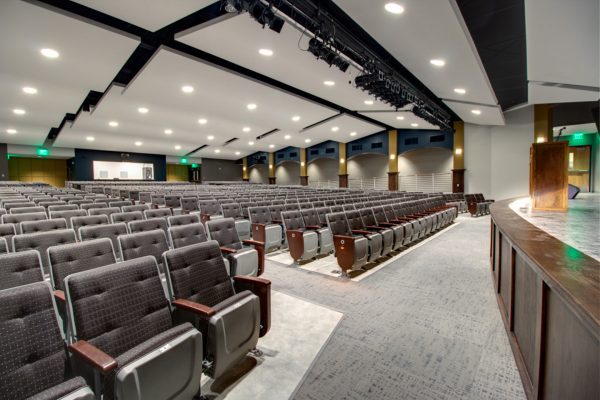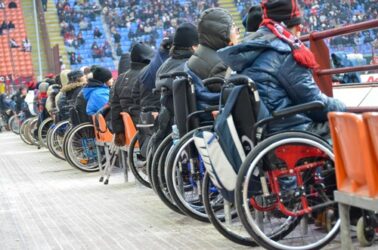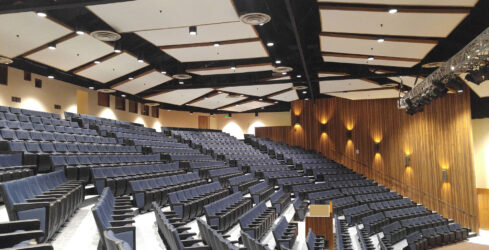Audience Seating Aisle Width: Ensuring Safety and Accessibility
 Aisle width is a crucial consideration when designing audience seating spaces. Adequate aisle width is essential for ensuring safe and efficient movement within the seating area, as well as providing accessibility for individuals with disabilities. In this article, we will dive into the importance of aisle width in audience seating and the factors to consider when determining appropriate widths.
Aisle width is a crucial consideration when designing audience seating spaces. Adequate aisle width is essential for ensuring safe and efficient movement within the seating area, as well as providing accessibility for individuals with disabilities. In this article, we will dive into the importance of aisle width in audience seating and the factors to consider when determining appropriate widths.
Importance of Aisle Width
Proper aisle width offers several benefits, including:
Emergency Egress:
- Sufficient aisle width enables quick and safe evacuation during emergencies, such as fires or other unforeseen situations.
- Aisles serve as primary exit routes, and wider passages facilitate the smooth flow of people, reducing the risk of congestion and ensuring a swift and orderly evacuation process.
Wheelchair Accessibility:
- Adequate aisle width is essential for individuals using wheelchairs or mobility devices to navigate through the seating area.
- Wider aisles allow for easier maneuverability, ensuring equitable access to seating spaces and amenities.
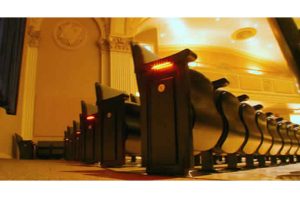 Movement and Comfort:
Movement and Comfort:
- Ample aisle width enhances the overall comfort of audience members, allowing for easy access to seats, concessions, restrooms, and other facilities.
- It facilitates efficient movement within the seating area, reducing congestion and enhancing the overall experience of attendees.
Factors to Consider for Aisle Width
Several factors influence the determination of appropriate aisle width in audience seating spaces:
Occupancy and Seating Capacity:
- Building codes typically define minimum aisle width requirements based on the occupancy type and seating capacity of the venue.
- The number of people expected to occupy the space directly influences the required aisle width to ensure safe evacuation and movement.
Accessibility Regulations:
- Accessibility standards, such as the Americans with Disabilities Act (ADA), establish guidelines for the minimum aisle width necessary to supply individuals using mobility devices or wheelchairs.
- These regulations ensure that all audience members, regardless of their physical abilities, can navigate the seating area safely and comfortably.
Evacuation Time:
- Thought should be given to the time expected for venue evacuation.
- Adequate aisle width allows for efficient movement and can help minimize evacuation time, enhancing overall safety.
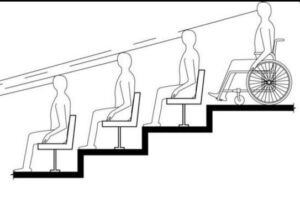
Sightlines and Clear Views:
- The design of aisles should consider maintaining unobstructed views for audience members, allowing them to see the performance or event clearly from their seats.
- Aisle width should be balanced with the need to provide optimal sightlines for all attendees.
Compliance and Safety
Adhering to the prescribed aisle width regulations is crucial to maintaining compliance and ensuring the safety of individuals within audience seating spaces.
- Non-compliance can pose serious risks during emergencies and may result in legal implications for venue owners.
Conclusion
Aisle width is a vital aspect of audience seating design, impacting both safety and accessibility. By providing adequate aisle width, venue owners and architects create an environment that allows for smooth movement, ensures equitable access for individuals with disabilities, and enhances the overall comfort and experience of the audience. Compliance with relevant building codes and accessibility standards is imperative to create seating spaces that prioritize safety, accessibility, and crowd management.



